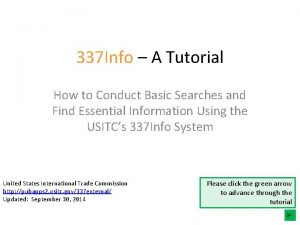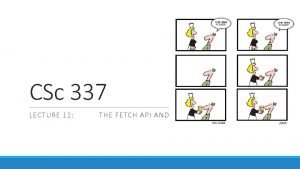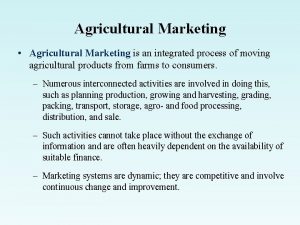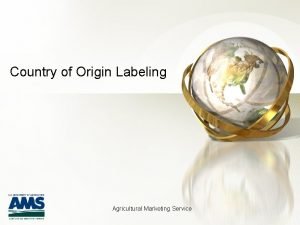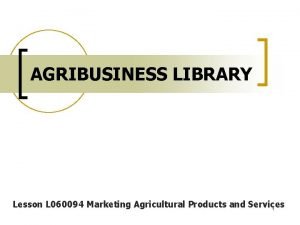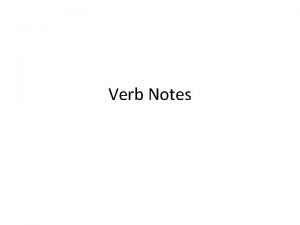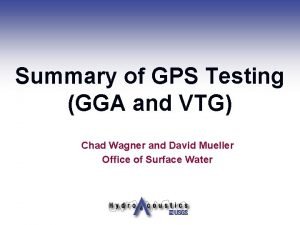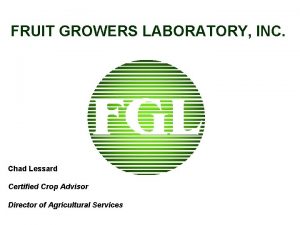ECON 337 Agricultural Marketing Chad Hart Associate Professor


























- Slides: 26

ECON 337: Agricultural Marketing Chad Hart Associate Professor chart@iastate. edu 515 -294 -9911

“New Generation” Contracts Ø Basic Hedge-to-Arrive Ø Basis Ø Deferred Price Ø Minimum Price Ø New Generation ØAutomated Pricing ØManaged Hedging ØCombination

Hedge-to-Arrive Ø Allows producer to lock futures price, but leaves the basis open Ø Basis is determined at a later date, prior to delivery on the contract Ø So the producer still faces basis risk and production risk (must produce enough crop to cover the contract) Ø The buyer takes on the futures price risk

Hedge-to-Arrive Ø Why might you use it? ØThink basis will strengthen before delivery Ø For the producer, the gain/loss on the contract is due to basis moves Ø Available in roll and non-roll varieties

Basis Contract Ø Also known as a “fix price later” contract Ø Allows producer to lock in basis level, but leaves futures price open Ø Producer still faces futures price risk and production risk Ø Buyer takes on basis risk

Basis Contract Ø Why might you use it? ØExpect higher futures prices, but possibly weaker basis Ø Example ØOn July 1, producer sells 5, 000 bushels of corn for November delivery at 20 cents under December futures. ØOn Nov. 1, Dec. futures set the futures price

Deferred Price Contract Ø Also known as “no price established” contract Ø Allows producer to deliver crop without setting sales price Ø Buyer takes delivery and charges fee for allowing price deferral Ø Producer still faces all price risk and production risk (if contract is set before delivery)

Deferred Price Contract Ø Producer also faces counterparty risk ØIf buyer files for bankruptcy, the producer becomes an unsecured creditor Ø Why would you use it? ØBelieve market prices are on the rise ØTakes care of storage ØAllows producer to lock prices at a later time Ø Producer benefits from higher prices and stronger basis, but risks lower prices and weaker basis

Minimum Price Contract Ø Allows producer to establish a minimum price in exchange for a service fee and the cost of an option Ø The final price is set later at the choice of the producer ØIf prices are below the minimum price, the producer gets the minimum price ØIf prices are above the minimum price, the producer captures a higher price

Minimum Price Contract Ø Removes downside price risk (below minimum price) and allows upside potential (after adjusting for fees) Ø Producer looking price increases to offset fees Ø Provides some predictability in pricing, can be set to be cash-flow needs

New Generation Contracts Ø Ever evolving set of contracts established to assist producers and users in marketing crops Ø Structured to overcome marketing challenges ØInability to follow through on marketings ØMarketing decisions triggered by emotion ØComplexities and costs of marketing tools

New Generation Contracts Ø Often broken into three categories ØAutomated pricing ØManaged hedging ØCombination contracts Ø Offered by several companies, each with its own twist on the contract Ø I will highlight some available contracts (for illustrative purposes only, not an endorsement)

New Generation Contracts Ø The contract follow predetermined pricing rules Ø Often sold in set bushel increments, like futures and options, with a specified delivery period Ø Some have exit clauses (depending on price)

Automated Pricing Ø In its purest form, basically locks in an average price by marketing equal amounts of grain each period within a set time ØCould be daily or weekly ØSome contracts allow producers to pick the pricing period Ø Can be combined with other pricing approaches (minimum price, etc. )

Automated Pricing Ø Examples ØAgri. Visor – Insight and Crossover Solutions ØE-Markets – Market Index Forward ØCargill – Pacer ØCGB – Equalizer Traditional Ø Variations ØCGB – Equalizer Over/Under ØE-Markets – Seasonal Index Forward

Automated Pricing period: Apr. to June 2016 on Nov. 2016 soybean futures

Automated Pricing Ø Advantages ØAutomates marketing decision, frees up producer time ØRemoves concerns about additional costs (margin calls) ØCan be set to capture average price when seasonal highs are usually hit

Managed Hedging Ø Automated contracts that implement pricing based on recommendations from market analysts Ø Examples ØCargill – Market. Pros ØProducers can choose to follow Cargill. Pros recommendations ØAgri. Visor – Insight ØProducers can choose to follow Agri. Visor, Doane, or Pro. Farmer recommendations

Managed Hedging Ø Has many of the same advantages as automated pricing Ø Results are dependent on the performance of the market analysts Ø Often has higher fees than automated pricing ØAutomated pricing: 3 -5 cents/bushel ØManaged hedging: 10 -15 cents/bushel

Combination Contracts Ø Extend or combine mechanisms from various contracts ØAveraging pricing ØMinimum pricing ØPricing based on market movements ØOpt-out clauses if prices fall significantly Ø Come in many varieties, so producers can find one to fit their needs

Agri. Visor Source: http: //www. agrivisor. com/Services/Crossover. Solutions. aspx

Agri. Visor Source: http: //www. agrivisor. com/Services/Crossover. Solutions. aspx

Accumulator Contracts – 2010’s Ø Accumulator Contract ØVersions for producers and consumers ØKey parameters: ØAccumulator price – price grain is sold (or bought) at ØKnockout price – price that terminates the contract ØWeekly bushel sales commitment ØHas acceleration function if price move beyond accumulator price Source: http: //www. intlfcstone. com/commodities/grains/Pages/Origination. Tools. aspx

Accumulator Quantity marketed doubles Normal quantity marketed Contract ends Source: http: //www. intlfcstone. com/commodities/grains/Pages/Origination. Tools. aspx

Consumer Accumulator Contract ends Normal quantity bought Quantity bought doubles Source: http: //www. intlfcstone. com/commodities/grains/Pages/Origination. Tools. aspx

Class web site: http: //www 2. econ. iastate. edu/faculty/hart/ Classes/econ 337/Spring 2017/index. htm
 Promotion from assistant to associate professor
Promotion from assistant to associate professor Heart 2 heart
Heart 2 heart 337 form example
337 form example Faa 337 form
Faa 337 form 337 form example
337 form example 337info
337info Adxl 337
Adxl 337 Csc 337
Csc 337 Csc 337
Csc 337 Marketing of agricultural products
Marketing of agricultural products What is agricultural marketing circle?
What is agricultural marketing circle? Scope of agricultural marketing
Scope of agricultural marketing Marketing mix of agricultural products
Marketing mix of agricultural products Chad b swim helping verbs
Chad b swim helping verbs Gga chad
Gga chad Rytmekontrol
Rytmekontrol Chad ulven
Chad ulven Wiu map
Wiu map Chad sigma
Chad sigma Chad topaz
Chad topaz Chad ostlund
Chad ostlund Chad posner
Chad posner Uiaddi
Uiaddi Fruit growers laboratory
Fruit growers laboratory Chad blight
Chad blight Mainframe ransomware
Mainframe ransomware Chad braley
Chad braley





